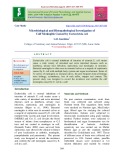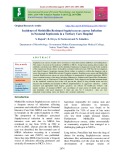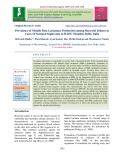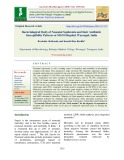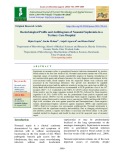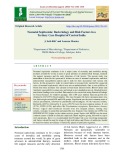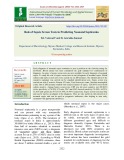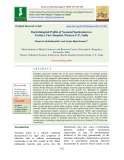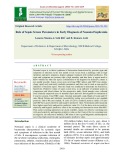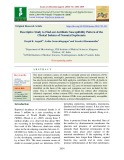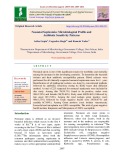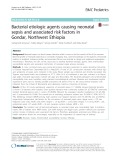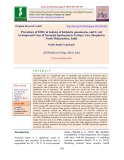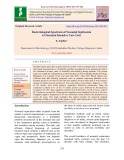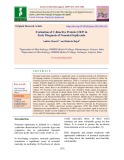
Neonatal septicemia
-
Escherichia coli is normal inhabitant of intestine of animals E. coli strains cause a wide variety of intestinal and extra intestinal diseases such as diarrhoea, urinary tract Infection, septicemia, and meningitis in neonates. Bacterial meningitis is often seen in neonatal calves as a sequele of septicemia caused by E. coli with multiple body system and organ involvement. Series of 32 calves of meningitis in neonatal calves, the post frequent clinical findings were lethargy, recumbancy, loss of suck reflex, stupper and comma.
 3p
3p  quenchua8
quenchua8
 29-09-2020
29-09-2020
 8
8
 1
1
 Download
Download
-
Staphylococcus aureus recently shows resistance to many Beta lactam antibiotics and Carbapenems. This study is focused on the incidence of MRSA in NICUs. Using Gram staining, blood culture and antibiotic sensitivity tests, MRSA can be identified. Septicemia is diagnosed not only by the isolation of the organism in blood culture. It should be correlated with total count, CRP like lab investigations and clinical features. Sometimes repeated blood culture is needed to confirm the diagnosis and to assess the prognosis.
 8p
8p  cothumenhmong7
cothumenhmong7
 09-09-2020
09-09-2020
 19
19
 3
3
 Download
Download
-
Neonatal septicemia is a clinically diagnosed condition having diverse etiology and changing antibiotic sensitivity pattern. The knowledge of common bacterial agents causing septicemia and their antibiogram is useful in deciding empirical antimicrobial therapy. The neonatal blood cultures were studied to know the bacterial species and their antibiotic sensitivity pattern. Aim of the study is to evaluate sensitivity pattern of bacterial isolates causing neonatal septicemia and to know clinical outcome of the cases.
 9p
9p  angicungduoc6
angicungduoc6
 20-07-2020
20-07-2020
 13
13
 1
1
 Download
Download
-
Neonatal septicemia is responsible for nearly half of neonatal deaths. With emerging drug resistance mechanisms like Metallo Beta lactamase (MBL) production, treatment of neonatal sepsis has become a challenge. The present study was done to identify prevalence of bacterial pathogens, their resistance profile and incidence of MBL mediated resistance among Gram negative bacterial isolates in neonatal sepsis. Seventy three cases of suspected neonatal septicemia were included in this prospective study. Blood culture was done by BacT/Alert 3D system, bacterial isolates were identified.
 7p
7p  angicungduoc6
angicungduoc6
 20-07-2020
20-07-2020
 10
10
 1
1
 Download
Download
-
Neonatal septicemia is still a leading cause of mortality and morbidity in developing countries like India. This prospective study involved 382 clinically suspected cases of neonatal septicemia over a period of one year from April 2014 to March 2015. Of the total 382 cases studied 174 (45.54%) were blood culture positive. Among the culture positive cases, septicemia was more common in male neonates, seen in 55.23%, compared to 44.76% of female neonates.
 8p
8p  quenchua6
quenchua6
 15-06-2020
15-06-2020
 11
11
 2
2
 Download
Download
-
India accounts for 30% of neonatal deaths globally. Bacterial sepsis is a significant cause of morbidity and mortality in newborns. The study helps to make antibiotic policy in neonatal sepsis. The main objective is to study the incidence of multidrug resistant gram negative and gram positive organisms causing neonatal septicemia and their antibiotic sensitivity pattern. The study was conducted in the Department of Microbiology over a period of one year. Sample of blood was collected under aseptic precautions and processed by standard techniques.
 5p
5p  gaocaolon5
gaocaolon5
 14-06-2020
14-06-2020
 20
20
 2
2
 Download
Download
-
Septicemia in neonates refers to generalized bacterial infection documented by positive blood culture in the first four weeks of life. Neonatal septicaemia remains one of the most important causes of mortality despite considerable progress in hygiene, introduction of new antimicrobial agents and advanced measures for early diagnosis and treatment. In this cross-sectional study, blood samples from the suspected infants were collected and processed in the bacteriology laboratory.
 7p
7p  caygaocaolon5
caygaocaolon5
 27-05-2020
27-05-2020
 22
22
 1
1
 Download
Download
-
Neonatal septicemia continues to be a major cause of mortality and morbidity among neonates around the world, in spite of great advances in antimicrobial therapy, neonatal life support measures and the early detection of risk factors. The present study was undertaken to describe the spectrum of isolates in cases of neonatal septicaemia, and their antimicrobial susceptibility pattern and to look for their association with various risk factors. In this prospective study in central India we prospectively enrolled the suspected cases of neonatal septicaemia, which were not on antimicrobials.
 10p
10p  kethamoi4
kethamoi4
 18-04-2020
18-04-2020
 23
23
 1
1
 Download
Download
-
Early diagnosis of neonatal sepsis continues to pose a problem to the clinician caring for newborns. Blood culture has been considered the gold standard for confirmation of diagnosis. An array of sepsis screen tests are now available for early diagnosis of neonatal sepsis. To study the role of sepsis screen tests in early diagnosis of neonatal sepsis. Blood cultures and sepsis screen tests were carried out on 200 neonates.
 6p
6p  quenchua4
quenchua4
 16-04-2020
16-04-2020
 20
20
 1
1
 Download
Download
-
Neonatal septicemia remains one of the most important causes of mortality despite considerable progress in hygiene, introduction of new antimicrobial agents and advanced measures for early diagnosis and treatment. Septicemia in neonates refers to generalized bacterial infection documented by positive blood culture in the first four weeks of life. To isolate and identify the bacterial etiologic agents responsible for neonatal sepsis and determine the antibiotic susceptibility pattern of isolates in a tertiary care hospital in Greater Noida, Western U.P.
 9p
9p  trinhthamhodang1212
trinhthamhodang1212
 06-04-2020
06-04-2020
 23
23
 1
1
 Download
Download
-
Neonatal sepsis is a clinical syndrome of bacteremia characterized by systemic signs and symptoms of infection in the first month of life. It has been a challenge with its high incidence and grave prognosis, despite adequate treatment with modern antibiotics. The signs and symptoms are protean with a high mortality and thus there is urgent need to know whether the baby has sepsis. Confirmation of the diagnosis by definitive culture is not rapidly possible.
 10p
10p  trinhthamhodang4
trinhthamhodang4
 22-03-2020
22-03-2020
 33
33
 0
0
 Download
Download
-
The most common causes of death in neonatal period are infections (32%) including septicemia, meningitis, pneumonia, diarrhea and neonatal tetanus. It has also been documented that birth asphyxia contributes for 29% of deaths in neonatal period. Patients presented to department of pediatrics (NICU), were examined clinically by pediatricians and 122 cases of neonatal septicemia were identified on the basis of the signs and symptoms and were included for the study. This is followed by collection of blood for culture after obtaining informed expressed written consent.
 6p
6p  trinhthamhodang4
trinhthamhodang4
 22-03-2020
22-03-2020
 20
20
 2
2
 Download
Download
-
Neonatal sepsis is one of the significant reasons for morbidity and mortality among the neonates in the developing countries. To determine the bacterial isolates and their antibiotic susceptibility pattern. Blood cultures were performed for all clinically suspected neonatal septicemia cases for 1 year. Identification of all pathogenic isolates was done by conventional methods followed by antibiotic sensitivity testing by Kirby bauer disk diffusion method. A total of 225 suspected for neonatal septicemia were included in this study. Among this 78(34.
 6p
6p  nguathienthan3
nguathienthan3
 27-02-2020
27-02-2020
 26
26
 0
0
 Download
Download
-
Neonatal sepsis is a blood stream infection which is seen in the first month of life of the neonate. Bacterial profile of neonatal septicemia is constantly changing thus, current knowledge on the patterns of bacterial isolates, its antibiotic resistance profile, and associated factors, are essential to design and implement appropriate interventions.
 10p
10p  vidr2711
vidr2711
 19-02-2020
19-02-2020
 19
19
 0
0
 Download
Download
-
Neonatal sepsis is a significant cause of morbidity and mortality in newborns and is responsible for 30 – 50 % of total neonatal deaths. Multidrug resistant Gram negative bacilli belonging to the family Enterobcteriaceae have been increasingly responsible for infections among the neonates admitted to the NICU in many countries including India. The study was conducted to know prevalence of ESBL production in Klebsiella pneumoniae and Escherichia coli in NICU so that we can help clinicians to avoid injudicious use of antibiotics.
 6p
6p  quenchua2
quenchua2
 18-12-2019
18-12-2019
 12
12
 1
1
 Download
Download
-
Neonatal septicemia either acquired from the mother (vertical transmission) or nosocomial (horizontal transmission) is a forbidable problem encountered in the neonatal unit and is the commonest primary cause of morbidity and mortality among neonates. The present study was conducted in Department of Microbiology, Dr B R Ambedkar Medical College, Bengaluru, over a period of one year from June 2016 – May 2017. Blood sample were collected from 100 clinically suspected cases of neonatal septicemia admitted in the neonatal intensive care unit.
 4p
4p  quenchua2
quenchua2
 16-12-2019
16-12-2019
 14
14
 0
0
 Download
Download
-
Neonatal septicemia constitutes a significant cause of neonatal mortality & morbidity in developing countries. It becomes essential to diagnose it as early as possible to reduce the mortality and treat with appropriate antibiotics. CRP is a sensitive & good inflammatory marker. Definite diagnosis of septicemia depends on positive blood culture, which takes around 48-72 hrs. Result of CRP test is available within an hour in tertiary care centers and remote areas, where there is no availability of well equipped laboratory setup for blood culture.
 7p
7p  kethamoi2
kethamoi2
 15-12-2019
15-12-2019
 13
13
 1
1
 Download
Download
CHỦ ĐỀ BẠN MUỐN TÌM








